The Period Necklace: A Thorough Investigation of Design and History
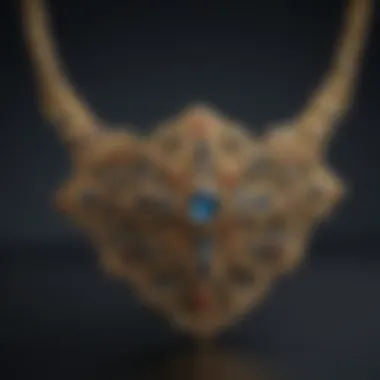
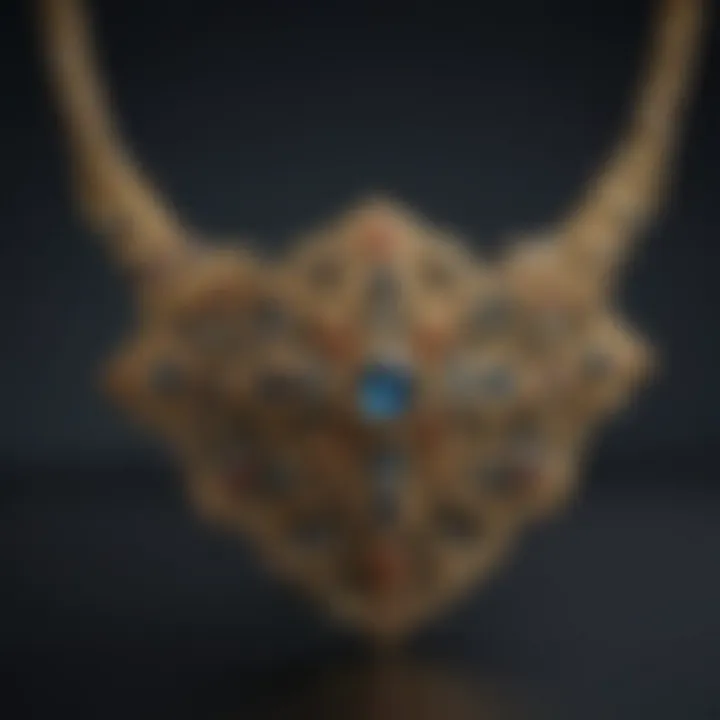
Intro
Period necklaces are not just accessories; they are threads weaving stories from different times and cultures. Understanding the world of period necklaces involves appreciating the craftsmanship, history, and significance embedded in each piece. In this exploration, we will delve deep into the gemstones that adorn these necklaces, providing insight into their characteristics and classifications.
A period necklace often signifies an era’s cultural ethos. For gemstone enthusiasts and collectors, these pieces serve not only as adornments but also as artifacts that hold great historical value. This article is structured to guide you through the fascinating journey of period necklaces, from their gemstone compositions to their broader implications in today’s jewelry market.
Gemstone Overview
Definition and Characteristics
Gemstones have always captured the human imagination. Defined as minerals or organic materials that can be cut and polished, these pieces of nature are celebrated for their rarity and beauty. Each gemstone possesses unique characteristics, such as:
- Color: The hue plays a crucial role in a gemstone's value.
- Clarity: Flaws can affect not just beauty, but also price.
- Cut: The way a gemstone is shaped influences its overall sparkle.
- Carat weight: Larger stones are generally more valuable due to their rarity.
Understanding these characteristics is essential for collectors who wish to appreciate their pieces fully.
Classification of Gemstones
Historically, gemstones are classified into two broad categories: precious and semi-precious. The distinctions are often based on factors like rarity, value, and uses. Precious gemstones include:
- Diamonds
- Sapphires
- Emeralds
- Rubies
Conversely, semi-precious gemstones encompass a larger variety, including:
- Amethyst
- Pearls
- Topaz
- Citrine
Each type offers a glimpse into the period it represents in necklace designs, enhancing the cultural narratives these pieces embody.
Historical Significance
Ancient Uses and Cultural Importance
Throughout the ages, necklaces have served various purposes beyond mere decoration. In ancient civilizations, gemstones were thought to possess protective properties, often being embedded in jewelry worn by warriors and nobility. By adorning themselves with specific stones, individuals sought to invoke their benefits. For instance, ancient Egyptians wore lapis lazuli to represent the heavens and signify divine connection.
Myths and Legends Surrounding Gemstones
Gemstones have rich mythological backgrounds as well. For example, amethyst was believed to prevent intoxication in ancient Greece, fostering its use in royal jewelry. Legends abound, passing through generations, fostering an aura of enigma around these stones.
In many cultures, pairing a gemstone with its specific period creates a narrative that resonates with history lovers and collectors alike. Period necklaces thus become not just personal adornments but also tangible connections to our shared human experience across centuries.
Understanding Period Necklaces
Period necklaces have a rich history and significant cultural relevance that goes beyond mere decoration. They serve as time capsules, encapsulating the artistry and societal values of their respective eras. In exploring period necklaces, one uncovers layers of craftsmanship and tradition that reflect the identities and aspirations of people throughout history. Understanding this topic is crucial for both jewelry enthusiasts and investors alike. It offers insight into the aesthetic choices and societal influences that have shaped necklace designs. Moreover, such knowledge enriches one's appreciation of the artistry involved, revealing how design elements link to wider cultural narratives.
Defining Period Necklaces
Period necklaces are intricate pieces of jewelry typically designed to represent a specific historical time frame or movement. Each period often showcases distinct characteristics in terms of materials used, design philosophy, and craftsmanship techniques. By defining what constitutes a period necklace, whether it be from the Renaissance or the Art Deco era, we can discern the evolutionary paths of jewelry design. This exploration helps us understand how societal changes— like political shifts, technological advances, or artistic revolutions— directly influenced the jewelry made during those times.
Historical Overview of Jewelry Eras
The historical overview of jewelry eras provides essential context. Each epoch is a wellspring of inspiration for contemporary jewelers and collectors. To grasp the significance of period necklaces fully, one must dive into the specific eras that contributed to the evolution of these adornments.
Ancient Civilizations
In ancient civilizations, necklaces often held deeper meanings beyond mere decoration. For instance, the Egyptians crafted elaborate gold necklaces adorned with turquoise and lapis lazuli, which were thought to possess protective powers. The uniformity and symmetry in their designs reflect a societal emphasis on balance and harmony. Such characteristics make these necklaces not just aesthetically pleasing but also culturally rich artifacts, signifying royalty and religion. The craftsmanship involved in these pieces is a testament to the skill of ancient artisans, offering valuable insights into the materials available and the techniques practiced at the time.
Middle Ages
The Middle Ages witnessed a fusion of religious motifs and personal expression in jewelry. Necklaces from this time often featured cross pendants or intricate beads, signaling faith as a fundamental aspect of daily life. The use of gold and precious gemstones became more prominent, indicating a rise in wealth and social stratification. This period's unique feature—its intertwining of spirituality and status— contributed to the popularity of such pieces for both ecclesiastical and secular wearers. However, while many of these necklaces serve as symbols of devotion, their intricate designs could sometimes be lost in layers of clothing, limiting their visual impact.
Renaissance
With the Renaissance came a revival of classical themes and a focus on humanism. Necklaces became more elaborate, showcasing not only precious materials but also intricate designs that celebrated nature and mythology. One key characteristic is the increased emphasis on personalization; pieces were often tailored to the individual, reflecting their status and values. This era also saw the introduction of techniques like enameling, enhancing the visual impact of necklaces. However, the complexity of these designs often made them less accessible to the average person, creating a divide in jewelry appreciation.
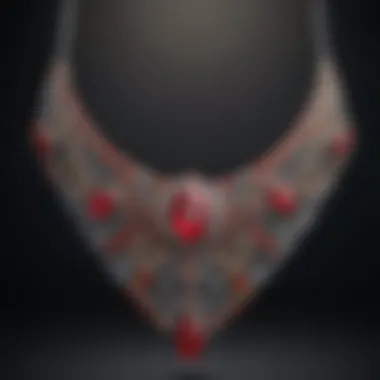
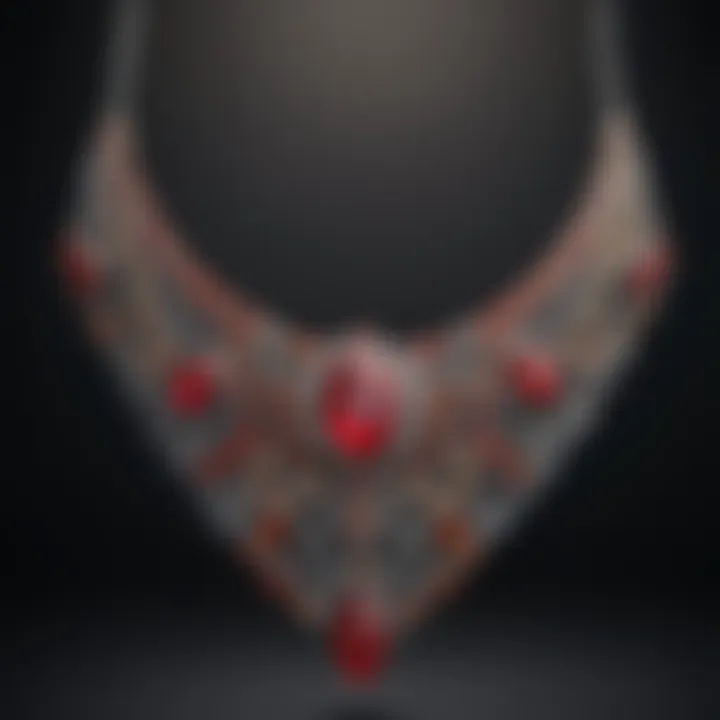
Victorian Era
The Victorian era introduced a more sentimental approach to jewelry design. Necklaces from this period often contained lockets or motifs representing love and loss. The personalization factor took center stage, as pieces were frequently given as tokens of affection or remembrance. A unique feature of the Victorian necklaces is their incorporation of symbolism—like the use of hair as a material representing connection to lost loved ones. While these sentiments are touching, it often complicated the understanding of value, making it challenging for modern collectors to evaluate their worth accurately.
Art Nouveau
Art Nouveau highlighted fluid forms and natural motifs. Necklaces from this period were characterized by organic lines and often featured themes drawn from flora and fauna. The craftsmanship in Art Nouveau jewelry reflects a deliberate move away from rigid structures towards more free-flowing designs. This era was notable for its embrace of artistic movements, inspiring jewelers to experiment with materials and unconventional designs. However, the embracing of nature sometimes led to fragility in the pieces, raising concerns about longevity.
Art Deco
Art Deco exploded onto the scene with its geometric designs and vibrant patterns. It emphasized modernity and an extravagant lifestyle. The distinctive features of Art Deco necklaces—such as the use of bold colors and unique shapes—revealed a divergence from the ornate styles that preceded it. This period represented an optimistic outlook, driven by advancements in technology following World War I. The downside is that some original pieces became victim to trends and fads, which might diminish their long-term value. Nevertheless, the aesthetic choices of this time have had a lasting impact on contemporary jewelry design.
"Understanding the evolution of period necklaces aids in appreciating their cultural contexts and the intricate stories they tell about humanity's artistic journey."
By exploring these historical epochs, it becomes evident how period necklaces not only represent aesthetic preferences but also hold significant social and cultural narratives. Their designs reflect the values and aspirations of their time, making them valuable not just as fashion items, but also as historical artifacts.
Key Characteristics of Period Necklaces
Understanding the key characteristics of period necklaces is essential for anyone navigating the intricate world of jewelry, especially in how these distinctive pieces reflect their epoch's craftsmanship and cultural narratives. Each attribute—from materials to design elements—carries its own story, allowing enthusiasts to appreciate the depth of these ornaments.
Materials Used
Materials lay the groundwork for the aesthetic and structural integrity of period necklaces. Each choice reflects not only the era's technology but also prevailing tastes and societal values. This focus goes beyond mere decoration; it represents a fusion of art and history.
Metals: Gold, Silver, Platinum
The primary metals used in period necklaces—gold, silver, and platinum—each tell a story of luxury, trade, and artistry. Gold is often seen as the king of metals, symbolic of wealth and perseverance. Its malleability makes it perfect for intricate designs and detailed craftsmanship. Silver, on the other hand, relates to purity and has a reflective quality that enhances many gemstone settings. Finally, platinum is marked by its resilience; it resists tarnishing. Collectors often admire platinum for its durability, showcasing pieces that can last generations.
Despite their advantages, not all metals are universally appealing. For instance, while gold can be highly sought after, its price is also volatile, making it a variable investment. Silver can tarnish, requiring proper care, and platinum’s rarity may limit its availability, which could reduce choices for buyers.
Gemstones: Loose vs. Mounted
When discussing gemstones, one must consider their form: loose or mounted. Loose gemstones offer versatility, allowing for customization; they can be set in various ways or paired with different metal settings. This characteristic allows wearers to express personal styles or sentiments, a trend that has gained traction in modern jewelry design. Conversely, mounted gemstones are typically set at the time of creation, ensuring they are tailored to a specific vision, embodying historical techniques.
However, loose stones may incur higher costs for setting, and issues may arise regarding authenticity, especially for beginners. Mounted stones can often signify authenticity when tied directly to historical pieces, but they limit one’s options for future customization.
Other Materials: Glass and Enamel
Apart from metals and gemstones, other materials like glass and enamel play a significant role in period necklaces. Glass, often used for beads, can mimic precious stones, providing an affordable yet stylish alternative. Its wide variety of colors enhances the visual appeal of necklaces. Enamel, on the other hand, brings intricate artwork into play, with its ability to add color and design intricacies, often reflective of the time period’s style.
These materials often serve as an accessible entry-point for collectors without breaking the bank. They're less fragile than one might think; nonetheless, glass pieces can be susceptible to scratches, and not all enamels endure the test of time without proper care.
Design Elements
Design elements in period necklaces reveal much about the cultural climate of their time. These patterns and styles can resonate with aesthetics and emotional sentiments that are key to every era of jewelry fashion.
Shapes and Styles
Shapes define how a period necklace is perceived. From the geometric forms of Art Deco to the flowing, organic shapes of Art Nouveau, each style communicates unique ideologies and inspirations. Renaissance designs often embraced symmetry and balance, appealing to a sense of order and beauty. The shape of a necklace can significantly impact its appeal and market potential. A unique cut or an unconventional style can set trends, making styles like the bib or choker increasingly popular in contemporary contexts.
Yet, pushing the boundaries with shapes can be risky. Some buyers might prefer traditional forms that stand the test of time, making avant-garde designs less appealing to a wider market.
Color Schemes and Patterns
Color schemes and patterns are another vital aspect of design. Vibrant colors can evoke different emotions, while patterns often reflect the cultural motifs of their era. For example, the pastel hues of Art Nouveau often contrast sharply with the bold colors seen in Victorian pieces. Using color theory effectively can elevate a piece from ordinary to extraordinary.
However, an overabundance of color may overwhelm a necklace, and mismatched hues can detract from its overall integrity and marketability. Buyers may favor classic palettes that retain sophistication over time.
Symbolism in Jewelry Design
Finally, symbolism plays a crucial role in the narrative of period necklaces. Designs often incorporate motifs with specific meanings, such as the use of hearts in romantic pieces, or animals representing traits like courage or loyalty. This ability to convey deeper meanings through design creates an emotional connection with wearers.
Navigating symbolism can be complex; some motifs might be lost on contemporary audiences. However, this factor can add a layer of cultural depth that resonates with collectors. Balancing trend and symbolic significance can enhance the piece’s story and appeal.
"Jewelry is the most transformative thing you can wear."
This quote emphasizes how understanding the essential characteristics of period necklaces allows us to appreciate their transformative power in both style and significance.
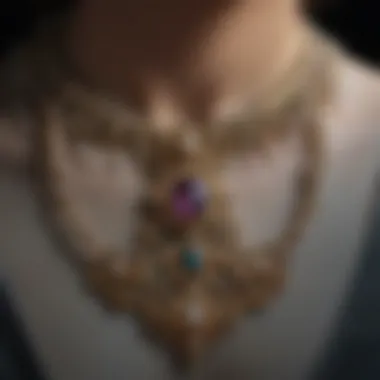
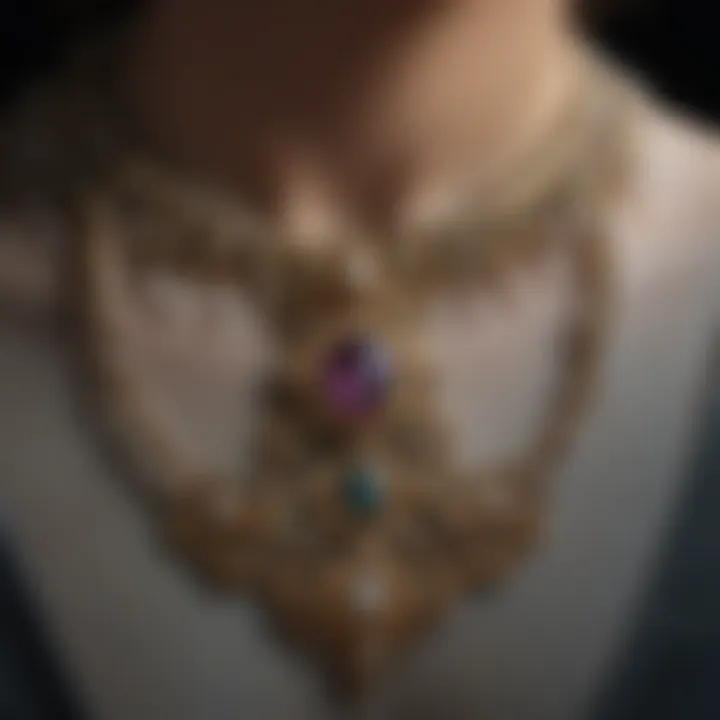
Cultural Significance of Period Necklaces
The cultural significance of period necklaces reflects their integral role in social structures and expressions throughout history. These jewelry pieces are not merely ornamental; they embody a narrative that traverses generations. Each necklace, with its unique design and craftsmanship, captures the essence of its time, speaking volumes about the makers and the wearers. Within contemporary society, these adornments also promote an understanding of heritage and personal identity, lending themselves as symbols of connection to ancestry.
Necklaces in Social Context
Jewelry as Status Symbols
Period necklaces have historically served as status symbols, often indicating wealth and social standing. For many cultures, the type of metal used, the intricacy of design, and the quality of gemstones employed tell a story about the owner's affluence. For instance, during the Victorian era, wearing elaborate pieces encrusted with diamonds or rubies could fundamentally elevate one's status within the social hierarchy. The conspicuous display of wealth not only granted respect from peers but also carved a niche of influence in societal norms.
However, this relationship with status can create a pressure that might overshadow the intrinsic beauty of the jewelry itself. Owning a piece from a specific period could lead to a superficial appreciation based primarily on its financial value rather than its artistic quality or historical importance.
Marriage and Engagement Traditions
The role of necklaces in marriage and engagement traditions carries significant weight across various cultures. The exchange of necklaces, particularly those embedded with precious stones, can symbolize love and commitment. For example, the use of a diamond necklace in engagement ceremonies is rooted in the belief of eternal love, as diamonds were thought to symbolize strength and invincibility.
The choice of a necklace in these traditions highlights a personal touch; often, families pass down these pieces, intertwining their stories with those of the couples. Yet, this practice can sometimes impose expectations—such as the idea that expensive jewelry equates to the profoundness of one’s feelings—creating a discord between personal sentiment and societal norms.
Religious and Cultural Ceremonies
Period necklaces also play a vital role in religious and cultural ceremonies, often serving as markers of identity and belief. In various cultures, necklaces are worn during rites of passage, blessings, or religious observances, imbuing the pieces with further significance beyond their physical attributes. For instance, in some indigenous cultures, a necklace might signify one’s tribal affiliation or spiritual beliefs, elevating its importance to that of a cultural treasure.
Despite their positive connotations, the reliance on necklaces in these contexts can raise questions about commodification and authenticity. When tradition intertwines with market forces, there can be a tension between preserving cultural integrity and appealing to modern consumerism.
The Role of Necklaces in Fashion
Influences from Iconic Figures
Iconic figures often shape the perception and desirability of period necklaces. Whether it be a Hollywood star gracing the steps of an awards show or a royal family member attending a public event, these individuals can set trends that resonate beyond their immediate context. For instance, Jacqueline Kennedy Onassis’ love for pearl necklaces sparked a resurgence in interest for classic designs in the mid-20th century.
The influence exerted by these figures tends to blur lines between personal expression and societal trends, pushing enthusiasts and collectors to seek pieces that reflect their admiration for particular personas. Nonetheless, this often leads to fleeting trends that may overshadow the deeper historical narratives behind the jewelry.
Impact of Historical Events on Styles
Historical events significantly impact necklace designs, with shifts in culture and technology driving trends. For instance, the Art Deco movement arose during the Roaring Twenties, a time of post-war optimism, showcasing bold geometric designs and innovative materials that represented newfound freedom and exuberance.
However, this evolution of style could risk losing sight of the craftsmanship and artistry inherent in earlier designs. Often, wearers might gravitate towards the aesthetic without embracing the story each piece tells, sidelining the deeper significance and craftsmanship that period necklaces embody.
Modern Fashion Trends Influenced by Period Necklaces
Modern jewelry design sees a resurgence of period necklace styles, with designers often drawing inspirations from the past while infusing contemporary approaches. This synthesis of old and new allows for a dynamic dialogue about heritage and innovation, making period necklaces suitable for various occasions.
Despite the excitement surrounding these trends, there can be pitfalls in how period styles are interpreted. Some modern reproductions may lack the authenticity or craftsmanship of their historical counterparts, which can lead to debates over value and desirability among collectors and enthusiasts. This presents a double-edged sword: while styles may become more accessible, there is a risk of diluting the historical essence that originally defined these beautiful pieces.
As they bridge generations, period necklaces remind us that jewelry is more than an accessory—it's a reflection of our shared human journeys.
Investing in Period Necklaces
Investing in period necklaces isn’t just about throwing your money around on shiny trinkets. It’s a nuanced venture that requires a blend of passion, knowledge, and a keen eye for detail. Each necklace tells its own story, steeped in the historical and cultural contexts of its time, making them not only beautiful but also filled with potential financial appreciation. Whether you're a collector, a jewelry enthusiast, or someone looking to diversify your investments, understanding this intricate market can yield significant dividends.
Understanding Value and Rarity
Factors Affecting Value
When considering period necklaces, one can't overlook the specific factors that can influence their value. At the forefront is rarity. A necklace crafted during a specific era, especially one that has survived the tests of time, stands as a unique piece in the ever-evolving market of jewelry. For example, an Art Nouveau necklace made from iridescent glass and naturistic motifs carries a different weight than a more modern piece. The rarity makes these necklaces sought-after items in auctions and collectors’ circles.
Moreover, the craftsmanship plays a crucial role too. Necklaces that show a high degree of artistry, intricate detailing, or unique design elements are often valued more than others. It's beneficial to educate oneself about the hallmark stamps or engravings that can help pinpoint the jewelry’s era and authenticity. Understanding how these factors interplay will give you a competitive edge in the marketplace.
Market Trends and Demand
Another pivotal aspect to consider is the market trends and demand for these pieces. This fluctuating landscape can be influenced by various factors, including economic conditions, popular culture, and even celebrity endorsements. For instance, certain eras, such as Victorian or Art Deco, have seen a resurgence in popularity due to shifts in fashion and design preferences in contemporary jewelry.
Keeping an eye on these trends can help you make informed decisions. If buzz is generating around, say, Vintage YSL necklaces, it may be wise to invest sooner rather than later. However, recognized trends can also lead to inflated prices, making discernment vital. Therefore, an astute investor must navigate this tumultuous terrain with caution and awareness.


Evaluating Authenticity
Authenticity is a major player in the value equation. Without verifying the provenance of a necklace, you might be walking into a minefield of counterfeit pieces. To ensure authenticity, an investor should look for thorough documentation, such as certificates from recognized appraisers or reputable sellers. The hallmarking system is another valuable asset here; knowing how to interpret these symbols can significantly protect one’s investment.
In some less transparent markets, individuals may find themselves with fake or misrepresented items, which can be quite disheartening. Thus, cultivating the right connections in the industry, and perhaps even hiring experts when necessary, can ensure the integrity of your collection.
Care and Maintenance
Best Practices for Preservation
Once you’ve invested in period necklaces, proper care becomes paramount. Each piece requires specific attention based on its materials. For example, gold necklaces can tarnish if not kept in optimal conditions, while pearls should be stored in breathable fabric to maintain their luster. Utilising jewelry cleaning kits designed specifically for historical pieces is beneficial, as they usually incorporate gentle formulas.
Additionally, creating a routine check—for scratches or damage—can preserve the condition of your necklace. Even if you don't plan on selling right away, keeping these beauties in tip-top shape ensures you'll enjoy their aesthetic for years to come.
Storage Tips for Different Materials
When it comes to storage, missteps can be costly. Each material demands its own treatment. For instance:
- Gold and silver jewelry should be stored in acid-free tissue or anti-tarnish pouches to prevent discoloration or scratching.
- Gemstone pieces must be kept separate from one another, ideally in padded compartments, to avoid abrasions.
- Enamel or glass items benefit from being stored upright to mitigate breakage.
By adhering to these practices, collectors can prolong the life and beauty of their necklaces.
Seeking Professional Appraisals
Engaging a professional appraisal service can be invaluable in the world of period necklaces. Not only do these experts provide a detailed evaluation of your collection, but they also consider the current market trends, ensuring you’re not missing out on potential financial benefits. Regular appraisals can also serve as a safeguard against market fluctuations, providing insight into when could be the right time to sell.
However, one must choose their appraisers wisely; they should have a solid reputation within the industry. The cost associated with this can vary, yet the peace of mind it brings and the confidence in your valuation are worth it. Therefore, staying informed and connected to professionals can amplify your investment strategy, keeping you ahead of the game.
Modern Applications of Period Necklaces
The significance of period necklaces in today’s world goes far beyond just aesthetics. With a rich history and deep cultural roots, they serve multiple purposes today, from fashion statements to family heirlooms. Their modern applications reflect changing societal views, new artistic expressions, and an increasing awareness of sustainable practices within the jewelry industry. Each necklace tells a story, carrying whispers of the past into the present, often reinterpreted for contemporary tastes.
Contemporary Adaptations
Revival of Vintage Styles
The revival of vintage styles in necklace design has brought forth a resurgence of interest in period jewelry. Consumers today seek a connection to the past, craving unique pieces that tell their own narrative. Vintage designs often possess intricate detailing that mass-produced jewelry lacks, showcasing craftsmanship that stands the test of time. The key characteristic here is the nostalgic appeal; these pieces tap into a collective memory that many find alluring.
A unique feature of this trend is the mix and match approach embraced by modern jewelers. They often combine elements from various eras, creating new styles that pay homage to the old while catering to current sensibilities. This blending can be both beneficial and challenging. On one hand, it opens doors for creativity, yet it forces designers to balance respect for tradition with demands for innovation.
Customization in Modern Jewelry Design
Customization stands as a hallmark of contemporary jewelry design, allowing individuals to create pieces that reflect their personality and story. This personalization mirrors a growing desire among consumers for individual expression. In the realm of period necklaces, this means adapting styles to feature specific gemstones or engravings that hold personal significance.
A distinguishing aspect of customization is its democratizing force; everyone, from the affluent to the average student, can participate in creating something uniquely theirs. However, with this trend, there are potential downsides. Custom pieces can sometimes be less durable than traditional ones, especially if the quality of materials is compromised in favor of unique designs.
Celebrity Influence on Modern Necklaces
Celebrity influence significantly shapes contemporary jewelry trends, with stars often setting the stage for what's fashionable. Period necklaces frequently end up in the spotlight, as many celebs choose to don historical designs, drawing attention to their charm and artistry. This phenomenon not only boosts exposure but enhances desirability among collectors and fans alike.
The key characteristic that drives this trend is the visibility of these pieces on high-profile figures. Such exposure can lead to a surge in interest in specific styles or eras, as followers seek to replicate the looks of their idols. However, this trend can sometimes blur the line between genuine appreciation and fleeting gimmicks. While it brings exciting designs into the public eye, it raises questions about how long such styles can hold relevance in the ever-evolving fashion landscape.
The Future of Period Necklaces
Emerging Trends in Jewelry
Emerging trends in jewelry reveal a vibrant landscape that is continuously evolving, influenced by art, technology, and cultural dialogues. Current trends draw from historical elements while also addressing the preferences of modern consumers. Minimalistic designs that celebrate the uniqueness of individual gemstones, alongside bold statement pieces, are gaining traction. Furthermore, there is an increasing blending of technology with traditional techniques. It is a mix that intrigues both jewelers and collectors alike.
The unique feature of these trends is the sustainability movement, which emphasizes eco-friendly practices in jewelry production. This acknowledges the ethical implications of mining and crafting jewelry and resonates with consumers who prioritize responsible purchasing.
Sustainable Practices in Jewelry Manufacturing
Sustainable practices in jewelry manufacturing are gaining momentum as society becomes more environmentally conscious. Jewelers today are embracing eco-friendly materials, such as ethically-sourced diamonds and recycled metals, which significantly impacts the period necklace market. This shift aims to enhance the overall transparency in production processes, ensuring that consumers can make informed choices.
A key characteristic of sustainable practices is the emphasis on innovation. Jewelers are exploring new techniques that minimize waste while maximizing beauty. However, transitioning towards sustainable practices can also present challenges. The initial costs of sourcing ethically can be high, and some consumers may be hesitant to embrace these changes without understanding their value.
Preserving Tradition While Innovating
The balance between preserving tradition and innovating is critical in the jewelry industry. Modern designers face the challenge of honoring the techniques and styles that define period necklaces while also integrating contemporary elements to appeal to today’s market. The key aspect of this balancing act lies in respecting historical craftsmanship while allowing for fresh interpretations.
This juxtaposition benefits both consumers and craftsmen. It cultivates a marketplace filled with deeply meaningful pieces that honor the past while looking forward to the future. Nevertheless, challenges exist, as not all interpretations are embraced equally. The delicate dance between nostalgia and modernity pressures designers to strike the right chord, ensuring their work resonates well in a multifaceted fashion environment.







